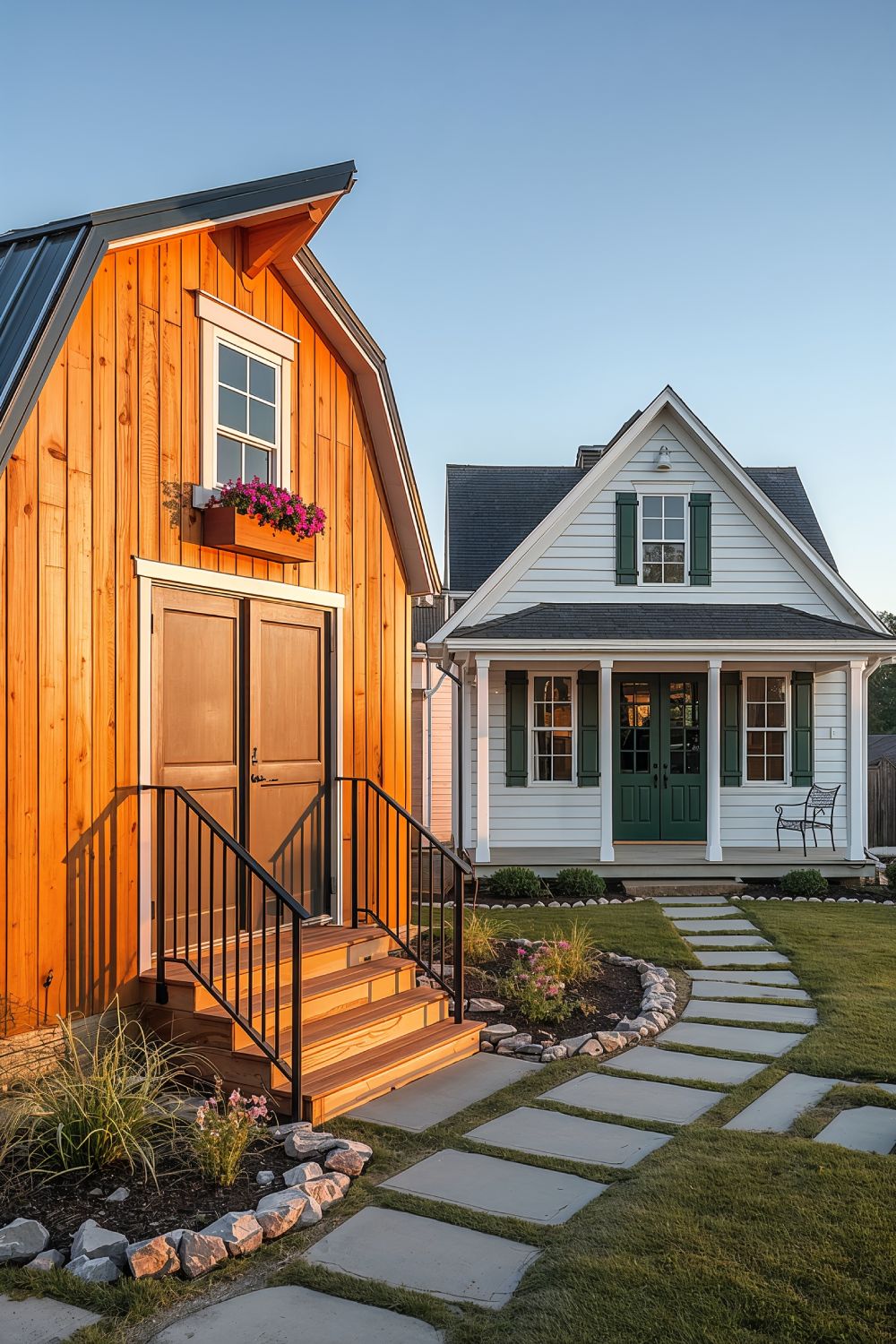Tiny shed house ideas bring together smart design and affordable living, transforming basic outbuildings into comfortable, stylish homes. As an expert in shed to house conversion with a track record of honest advice, I’ll reveal the top tips and strategies for creating your dream tiny home—from legal permits to clever storage. Whether you’re considering a barn style shed house, looking for budget-friendly solutions, or dreaming of an off-grid lifestyle, you’ll find actionable insights right here.

| Shed House Type | Square Footage | Average Cost Range | Best Use | Loft Available | Key Features |
|---|---|---|---|---|---|
| 10×24 Barn Style | 240 sq ft | $15,000 – $25,000 | Solo living, home office | Yes | Compact layout, sleeping loft, minimal kitchen |
| 12×20 Gable Style | 240 sq ft | $18,000 – $30,000 | Couple’s retreat, guest house | Optional | Ground floor bedroom, full bathroom, vaulted ceiling |
| 12×24 Lofted Barn | 288 sq ft | $20,000 – $35,000 | Small family, ADU rental | Yes | Two sleeping areas, full kitchen, storage stairs |
| 12×32 Cabin Style | 384 sq ft | $25,000 – $45,000 | Primary residence, vacation home | Yes | Separate bedroom, wraparound porch, full amenities |
| 16×40 Premium | 640 sq ft | $40,000 – $65,000 | Full-time living, multi-family | Yes | Two bedrooms, kitchen island, spacious living area |
| Prefab Shed Kit | 120-300 sq ft | $5,000 – $15,000 | DIY conversion, she shed | Varies | Quick assembly, basic structure, requires finishing |
1. Barn Style vs. Gable Style Sheds for Tiny Home Conversions
Your shed’s shape impacts everything from layout to curb appeal. The two most popular shed styles for tiny house shed designs are barn style and gable style. Let’s compare their strengths:

😍 Barn Style sheds (think classic “lofted barn shed”) offer maximum vertical space, making them excellent for lofts and storage. This style is ideal if you want to create a barn style shed with loft for a tiny home—great for families or anyone needing creative sleeping arrangements.
🏠 Gable Style sheds, with their peaked roofs, deliver a modern look and can be easier to insulate. Gable sheds work well if you prefer a classic, cottage-inspired tiny shed aesthetic.
“Barn style sheds give you the most bang for your buck if you want a loft. But gable sheds can be easier for first-time converters due to their simple construction.” — Brad Smith
Cons: Barn styles may cost more to insulate and finish due to their heights, while gable styles limit your options for an upper loft.
Pro tip: Measure your available lot space and look at prefab shed for tiny house conversion kits—most major manufacturers offer both barn and gable styles!
2. Essential Cost Breakdown for Converting a Shed into a Tiny House

Let’s get honest about shed house cost. Converting a shed into a tiny house can be cost-effective, but planning is key to avoid budget surprises. Here’s a typical breakdown:
- Shed shell: $3,000 – $15,000 depending on size and quality
- Insulation & weatherproofing: $1,000 – $5,000
- Interior finishes & fixtures: $5,000 – $10,000
- Plumbing, electrical, HVAC: $4,000 – $12,000
- Permitting/zoning fees: $500 – $3,000
🛠️ The cost to turn shed into house can range from $15,000 to $45,000+, still a fraction of traditional homes or many ADU tiny home kits.
Cons: Expect surprise costs—like needing better foundation work or custom utilities hookups.
Pro tip: Budget an extra 10% for unforeseen expenses, and compare local prefab shed prices to see if a custom build or kit is cheaper in your region.
3. Maximizing Space with Loft Designs in Tiny Shed Houses
Adding a loft is the best way to double usable space, especially in a lofted barn shed. Those soaring ceilings are perfect for bedroom nooks or bonus storage.

🛏️ How to add a loft:
- Frame a basic sleeping platform above part of the main area
- Use steel cables or brackets for added support in barn style sheds
- Ensure there’s enough clearance for sitting upright!
👪 Best for: Families or anyone who wants to keep the main floor open for living and dining.
“Lofts give you a ‘second floor’ in under 200 sq ft. Just make sure you can safely access it—install stairs or a secure ladder.” — Brad Smith
Cons: Lofts can get hot. Integrate a fan or vent window.
Pro tip: Paint your loft area bright white to make it feel airy and bigger.
4. Legal Requirements and Zoning Permits for Shed House Conversions
Before you start swinging a hammer, check the shed house zoning and permits in your area. Legal requirements for shed homes can vary dramatically!

📝 Key steps:
- Contact your city/county building office
- Ask if you can have an ADU tiny home or live in a converted shed
- Look up minimum size, set-back distances, and foundation codes
🚫 Skipping permits may bring fines or even require demolition—don’t risk it!
Pro tip: Read up on “how to convert a shed into a tiny house” for your specific state, as many have unique ADU guidelines.
“The biggest hurdle is often local permitting. Some regions embrace tiny homes; others make it nearly impossible. Do your research before investing.” — Brad Smith
5. Off Grid Living Solutions for Tiny Shed Homes

Dreaming of a rural retreat? An off-grid shed house is surprisingly attainable with today’s technology! Go off grid tiny shed house with these essentials:
☀️ How to set up:
- Install solar panels for power
- Use a composting toilet and rainwater collection
- Propane or tankless water heaters work great
Cons: Initial costs can be higher, and you’ll need to manage your own utilities.
😍 Perfect for: Adventurers, minimalists, and anyone with land outside city limits.
In 2023, over 16% of new tiny homes were designed for off-grid living—showing a rising trend in sustainable housing.
6. Best Shed Sizes and Layouts for Tiny House Living
Picking the right size and layout is crucial for comfort. Popular tiny shed house layout ideas typically range from 10×16’ to 16×40’—enough space for basics without feeling cramped.

🦺 Top layout tips:
- Open floor plan for kitchen/living
- Use one wall for kitchen + bath “wet zone”
- Place the loft above kitchen/bath to save space
Cons: Smaller sheds restrict bathroom and kitchen sizing.
🤏 Best for: Solo dwellers (10×16’), couples/small families (12×24’ or larger).
7. Insulation and Weatherproofing Your Shed House
To stay cozy year-round, expert insulation and weatherproofing is non-negotiable—especially for barn style shed houses with lots of roof exposure.

🌡️ How to insulate:
- Install foam board or spray foam between wall studs
- Wrap with vapor barrier
- Seal all gaps, especially around windows and doors
❄️ Pro tip: Use double-pane windows for year-round comfort.
Cons: Improper insulation causes mold and high energy bills.
“Cutting corners here will hurt you. Quality insulation is a must-have for every climate.” — Brad Smith
8. Creative Interior Design Ideas for Tiny Shed Homes
Tiny shed house interior design is where your style shines! Maximize light, create zones for living, and make every inch feel intentional.

🎨 Design essentials:
- Use light colors; whites and natural woods make spaces feel larger
- Install lots of windows or a skylight for natural light
- Add mirrors to visually expand the area
Pro tip: Multi-use nooks (like a fold-out desk by a window) add flexibility without clutter.
“Small can be stunning. Layer textures and stick to a simple color palette for a designer look.” — Brad Smith
9. Installing Utilities

Modern comforts in a shed house come down to utilities. When planning for tiny house shed designs, consider:
- Underground conduit for electrical
- Compact tankless water heaters for on-demand hot water
- Split mini HVAC systems—ideal for small spaces
🛠️ Process:
- Map plumbing/electrical before closing up walls
- Use PEX tubing for easy bathroom/kitchen installs
- Plan venting for bathroom and cooking appliances
Cons: Utility hookups can get costly, especially for rural lots.
😍 Works great for: Those wanting all the amenities of a full-size home—without the wasted space.
10. Multi Functional Furniture and Storage Solutions for Shed Houses

The secret to comfort in a tiny home? Smart, multi functional furniture and storage!
🪑 Choose:
- Built-in benches with drawers underneath
- Murphy beds or lofted bunks
- Collapsible tables and nesting chairs
“Every furnishing should work twice as hard—think seating that stores, tables that fold, and beds that disappear.” — Brad Smith
Pro tip: Use vertical wall storage—shelves, hanging baskets, and magnetic racks.
Cons: Custom built-ins can be pricier but often pay off in daily usability.
Transforming a shed into a tiny house means thoughtful choices: the right shed style, budget planning, creative layouts, proper permitting, and bold design touches. From off-grid solutions to space-maximizing lofts, every decision counts in making a small shed feel like a true home.
Pro tip: Schedule a free consultation with a local shed builder to discuss prefab options and get clarity on regional legal requirements.
Ready to turn your shed dreams into reality? Download our Tiny Shed House Planning Checklist or reach out for expert advice—your perfect tiny home awaits!

